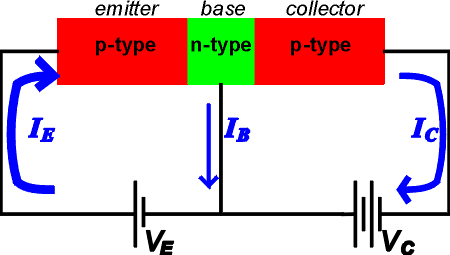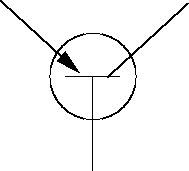
Transistors
A transistor is the
most crucial element in modern electronics. It serves as
an amplifier and as a switch. A single transistor will
adjust the output according to a small change in the
input. Just as a light switch can supply many hundreds of
watts power by the flick of a finger. Before transistors,
amplification and switching was done with vacuum tubes
which are enormously bulky and produce a great deal of
heat. Since a single microprocessor may hold near 5
million transistors, the advantage to 5 million vacuum
tubes is obvious.
A transistor is
constructed by sandwiching a layer of n-type
semiconductor between two segments of p-type material.

 The
small battery on the left serves as the switch. Without
that portion of the circuit, the large battery can not
pump current due to the n-p reverse bias of the
right-hand loop. By adding a small voltage VE,
a healthy current flows through the left-hand loop which
floods the narrow n-type region with charge which then
destroys the ability of the n-p junction to stop the
current. Thus a small voltage change in VE
creates a large effect. Thus it can serve as either a
switch or an amplifier. The circuit diagram for the
transistor is shown on the right. The upper left lead
represents the emitter, the upper right lead represents
the collector and the lower lead is the base. The
small battery on the left serves as the switch. Without
that portion of the circuit, the large battery can not
pump current due to the n-p reverse bias of the
right-hand loop. By adding a small voltage VE,
a healthy current flows through the left-hand loop which
floods the narrow n-type region with charge which then
destroys the ability of the n-p junction to stop the
current. Thus a small voltage change in VE
creates a large effect. Thus it can serve as either a
switch or an amplifier. The circuit diagram for the
transistor is shown on the right. The upper left lead
represents the emitter, the upper right lead represents
the collector and the lower lead is the base.
Semiconductor
device's index
|









 The
small battery on the left serves as the switch. Without
that portion of the circuit, the large battery can not
pump current due to the n-p reverse bias of the
right-hand loop. By adding a small voltage VE,
a healthy current flows through the left-hand loop which
floods the narrow n-type region with charge which then
destroys the ability of the n-p junction to stop the
current. Thus a small voltage change in VE
creates a large effect. Thus it can serve as either a
switch or an amplifier. The circuit diagram for the
transistor is shown on the right. The upper left lead
represents the emitter, the upper right lead represents
the collector and the lower lead is the base.
The
small battery on the left serves as the switch. Without
that portion of the circuit, the large battery can not
pump current due to the n-p reverse bias of the
right-hand loop. By adding a small voltage VE,
a healthy current flows through the left-hand loop which
floods the narrow n-type region with charge which then
destroys the ability of the n-p junction to stop the
current. Thus a small voltage change in VE
creates a large effect. Thus it can serve as either a
switch or an amplifier. The circuit diagram for the
transistor is shown on the right. The upper left lead
represents the emitter, the upper right lead represents
the collector and the lower lead is the base.